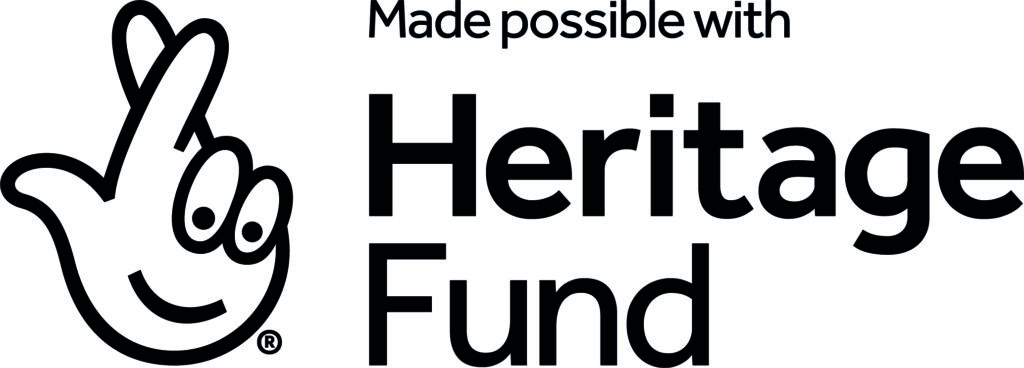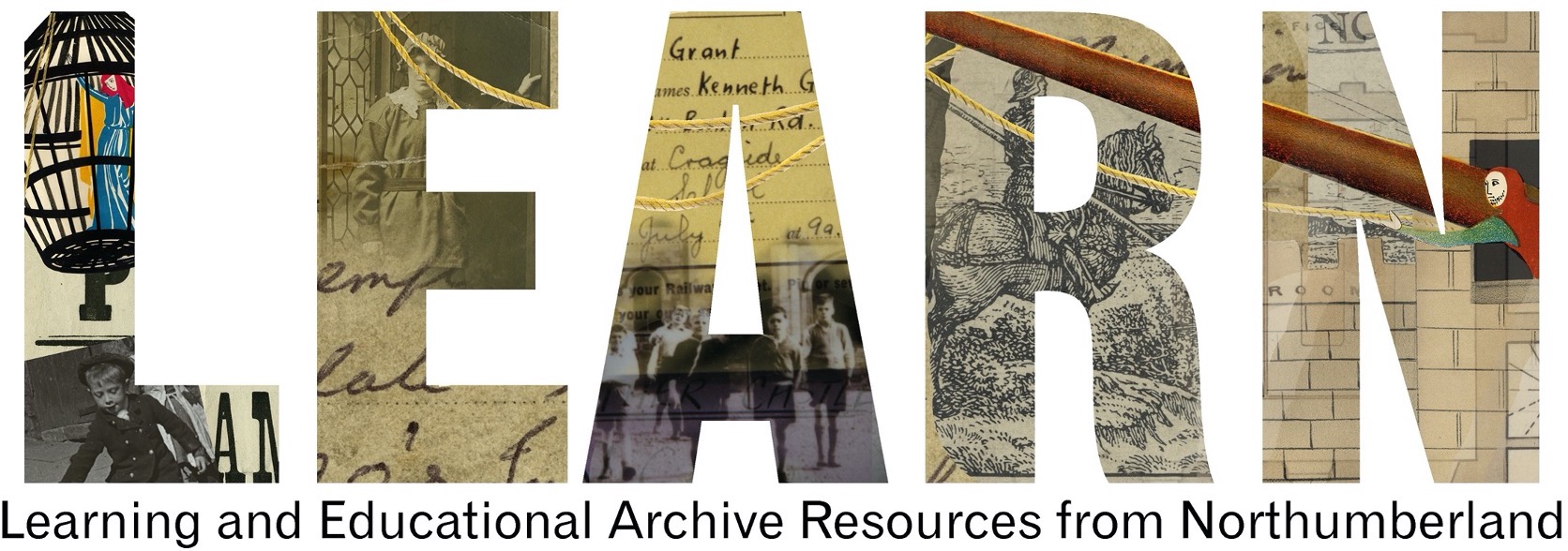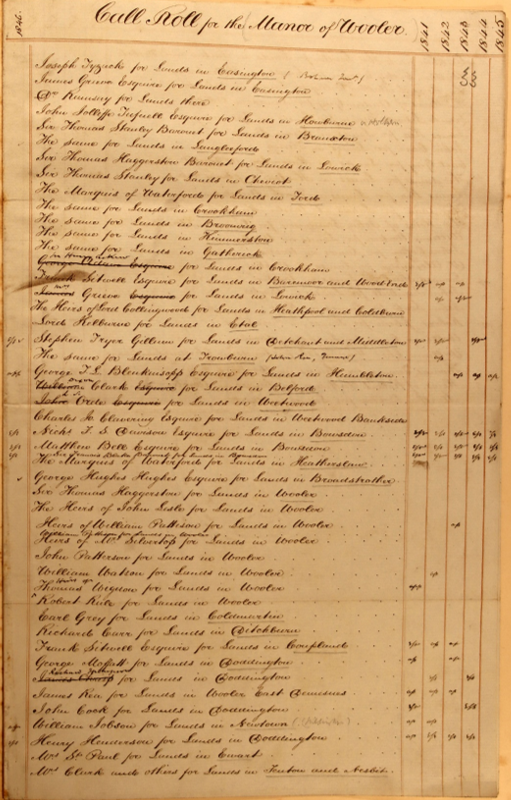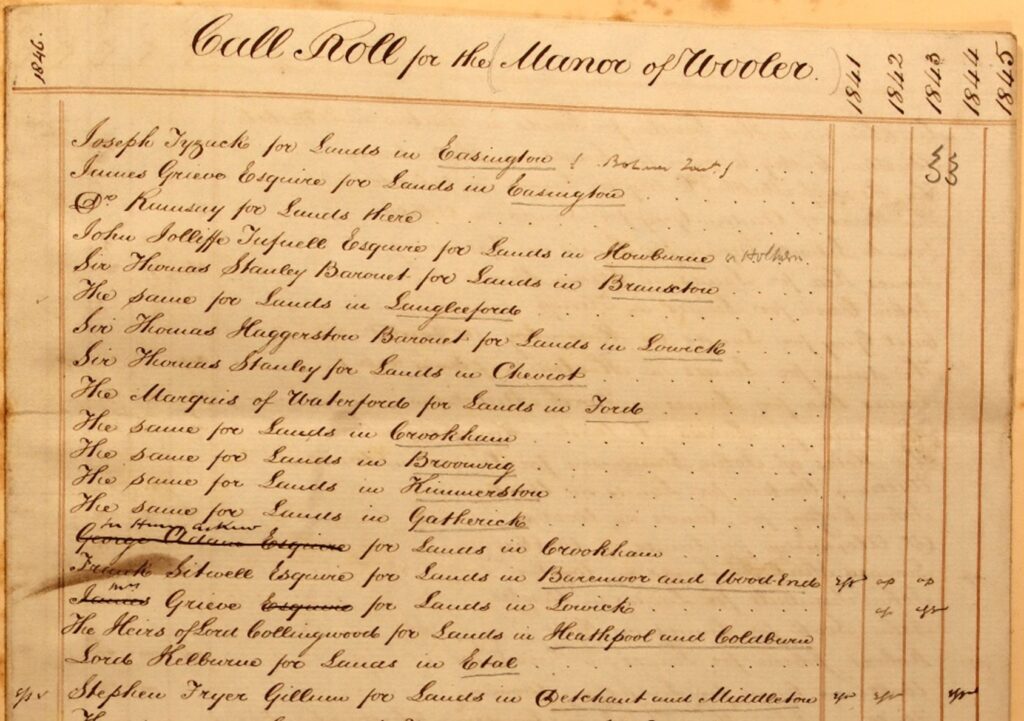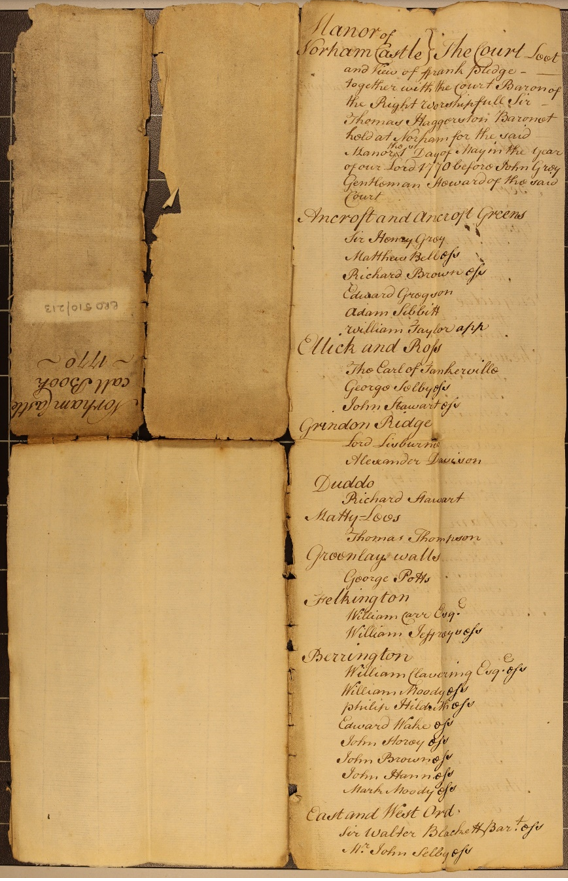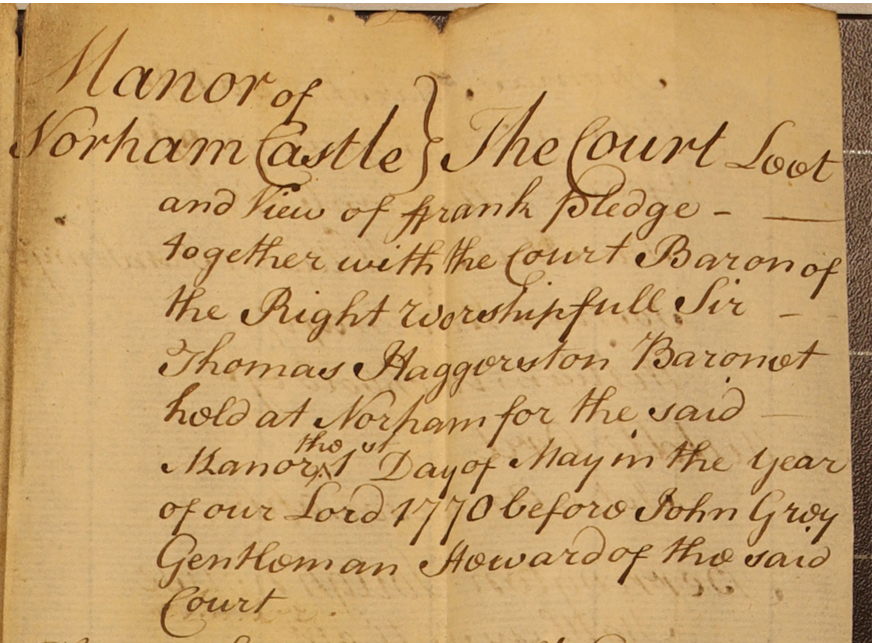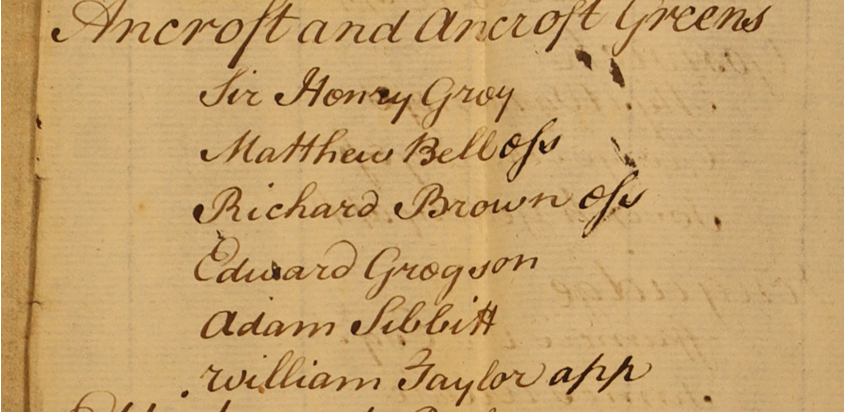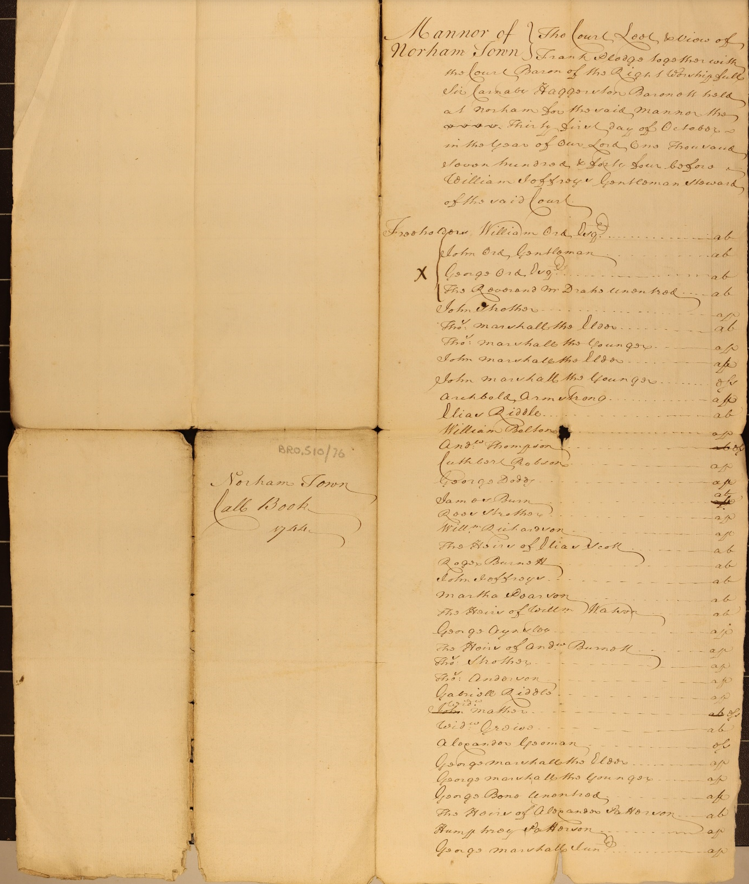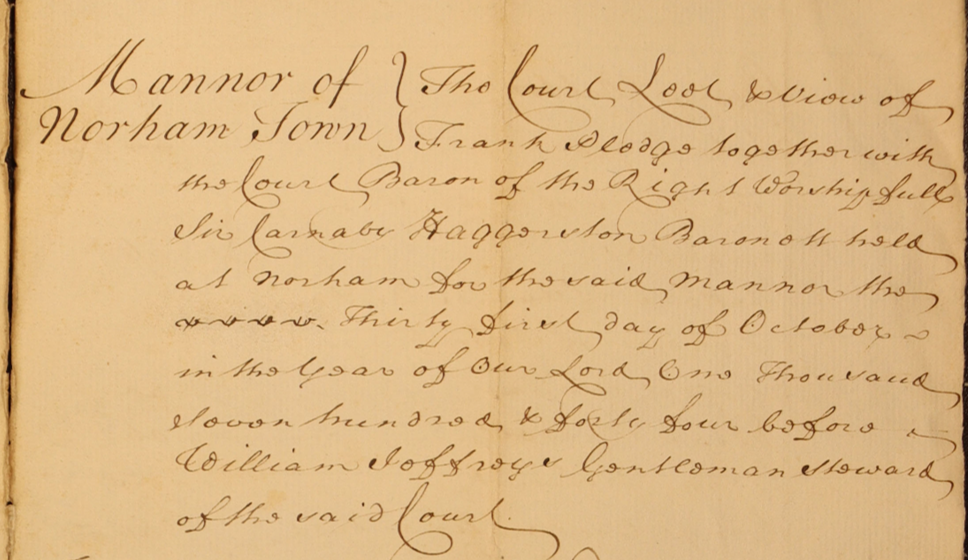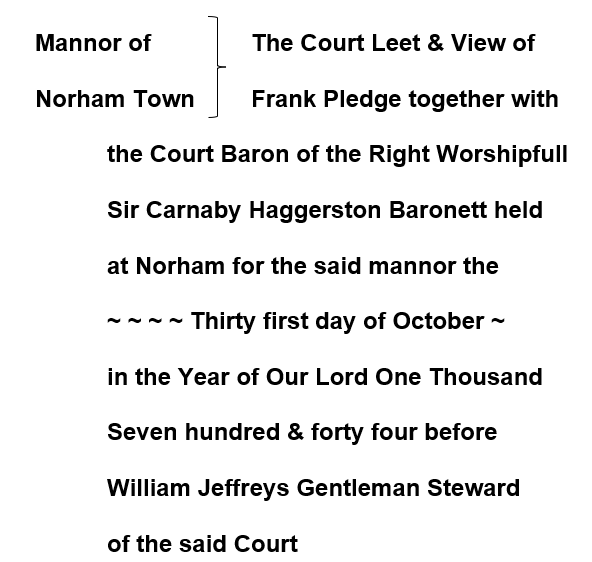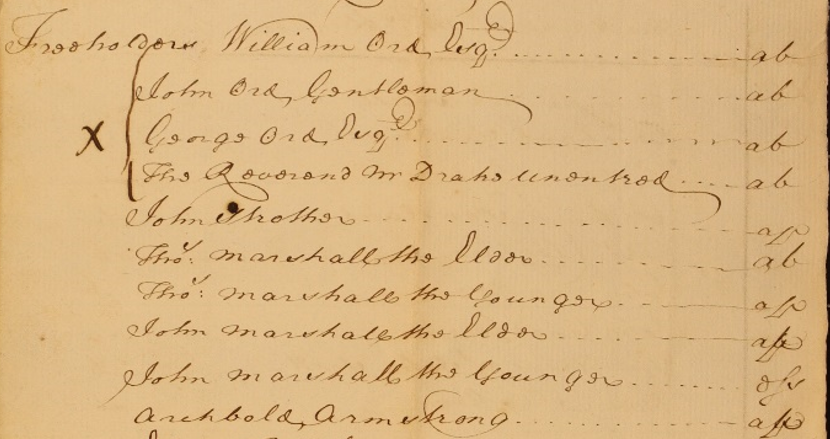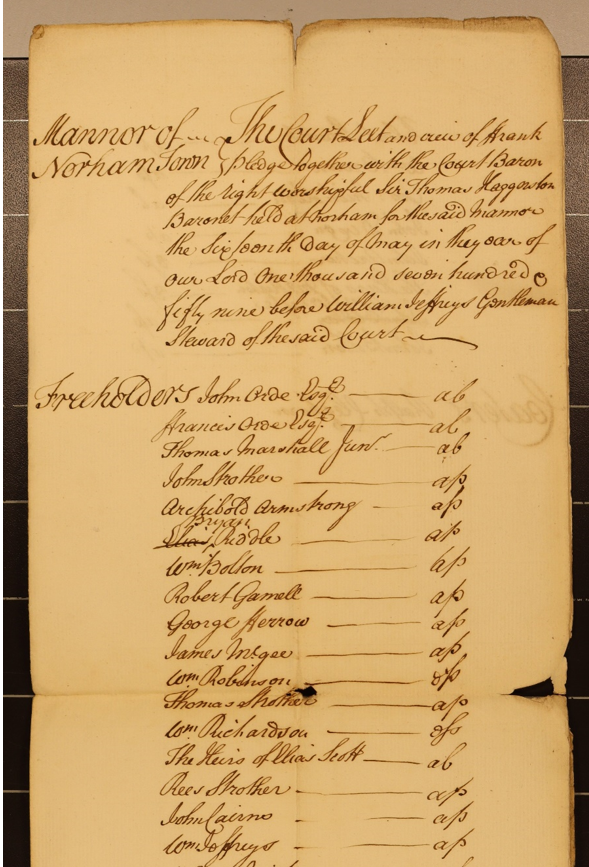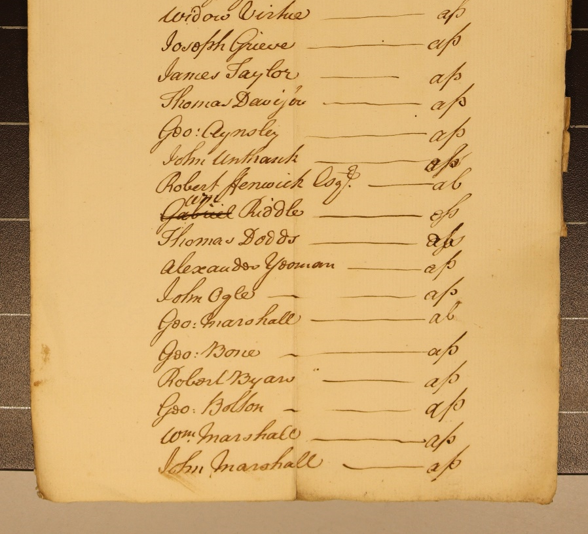Everyday Life in a Northumbrian Manor
All Manor of Things: An introduction to manors and their documents
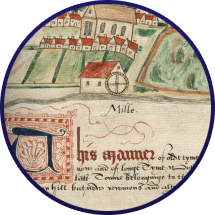
Call Rolls and Call Books
Call Rolls
Call rolls list tenants who were “called” to the manorial courts. They are sometimes called suit rolls. These include the name of the tenant and whether they appeared in court. Their attendance would be noted on the roll using letters, which represent an unexpanded word. These are explained in the table below: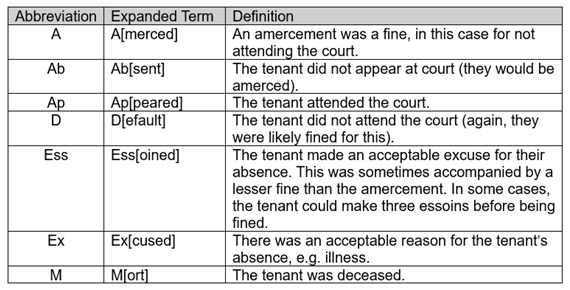
Call Books
Call books are very similar to call rolls but written into a book. While a call roll will have the usual manorial heading at the top (name of the manor, court, lord, date, steward), this may only be written on the first page of a call book. Other pages will just list the tenants for each year.
Here is an example of a page from the Wooler manor call book:
It covers 1841-1846 and is written in italic handwriting. Look at the extract below to see the top section in more detail.
Format
The name of the tenant is written first, then the location of their land, and finally in the smaller columns to the right, there are letters indicating whether they attended court or not. In this example, letters only appear against some of the tenants near the bottom of the list – “ap” for appeared or “ess” for “essoined” . It is unclear why the rest have been left blank, however, it probably means that the person did not attend and was amerced.
Activity - Test your reading
The questions and answers can be found in the drop down below.
Where did the following tenants have land?
- John Joliffe Tuffnell (4th entry)
- Sir Thomas Haggerston Baronet (7th entry)
- The Marquis of Waterford (9th, 10th, 11th, 12th, 13th entries)
- Howburne
- Lowick
- Ford, Crookham, Broomrig, Kimmerston, Gatherick.
Locations within the Call Book
The places mentioned in this call book are interesting. Normally a manor call roll lists the tenants in a manor, so this should be locations within Wooler manor, but here these places cover a large area of land. For example, both Ford and Lowick are listed, which are both manors with their own records.
It is not unusual for manors to extend into different towns or parishes, but here, this is a Barony instead of a Manor call roll. Wooler was a manor in its own right, but it was also part of Wooler Barony. A Barony is where one lord owns multiple manors, it may also be referred to as an “Honour” or “Lordship”. Another clue that this is a Barony call roll is the names listed. In this small section, for example, there is the Marquis of Waterford and Thomas Haggerston, Baronet, both important gentlemen, who were large landowners in North Northumberland.
Below is another example of a call roll, this time for Norham Castle manor. There are two manors in Norham, the manor of Norham Town and Norham Castle manor. It is not unusual to find multiple manors within one town or parish, so do bear this in mind when doing manorial research.
This is an individual call roll and not part of a volume, and so it has the usual manorial format at the top – see below:
This roll is about 70 years older than the Wooler call roll and it contains some secretary hand letter forms which were mentioned in the last section on court rolls.
- “Leet” (end of line 1) – this contains the theta form of “e”, looking a bit like an “o” with a line through.
- “Frank” (line 2 ) – This starts with “ff” but remember a double “f” is just a capital “F”.
Activity - Test your reading
The questions and answers can be found in the drop down below.
Find the following information in this section:
- The name of the court
- The name of the lord
- The date
- The name of the steward
Answers:
- The Court Leet and View of Frank Pledge together with the Court Baron
- Sir Thomas Haggerston, Baronet
- 1st May 1770
- John Grey, Gentleman Steward
Thomas Haggerston also appeared in our Wooler call roll as a landowner in Lowick. Thomas Haggerston was a common name in that family and given the 70 year gap between the two documents, this was probably an earlier Thomas Haggerston.
Tenants
Following the header of the call roll, the tenants are then listed by area – see below the tenants for Ancroft and Ancroft Greens:
While the attendance was neatly written in a table in the call book, here it has been added after the names. The ink is slightly darker, suggesting the scribe wrote up the call roll before the court and then added the attendance later.
Have a go at reading the names of the people.
They are:
Sir Henry Grey
Matthew Bell ess[oined]
Richard Brown ess[oined]
Edward Gregson
Adam Sibbitt
William Taylor app[eared]
Two men did not appear, but sent their apologies (essoins), and one man, William Taylor, appeared. Again, it is unclear what it means when there are no letters by a name. However, they were probably absent without an excuse and amerced.
Here’s a final example of a call roll, this time for Norham Town manor.
Here the format is very similar to the last example for Norham Castle manor. The handwriting is more challenging, but knowing what words should appear in the first paragraph will help build up a list of familiar letters.
Activity - Test your reading
When writing down the unusual letters, did you notice the following:
- “t” – the scribe does not cross through this letter and so , use context to work out if he means an “l” or a “t” – in line 3 the second word is more likely to be “Court” than “Courl”.
- “e” – the theta form of “e” appears in “Leet” (line 1).
- “v” – this letter often looks like a modern “u” – “View” (line 1).
Did you spot anything else?
Try reading the section below from the same court roll.
Fill in the gaps (the dashes denote the number of missing letters):
Freeholders William _ _ _ Esq[uir]e ab[sent]
John Ord _ _ _ _ _ _ _ _ _ ab[sent]
X George Ord Esq[uir]e ab[sent]
The Reverend Mr _ _ _ _ _ unentred ab[sent]
John Strother ap[peared] ap[peared]
Tho[ma]s Marshall the Elder _ _ [ _ _ _ _ ]
Tho[ma]s Marshall the _ _ _ _ _ _ _ ap[peared]
John Marshall the Elder _ _ [ _ _ _ _ _ _ ]
John Marshall the Younger es[soined]
_ _ _ _ _ _ _ _ _ _ _ _ _ _ _ _ _ ap[peared]
Freeholders William Ord Esq[uir]e ab[sent]
John Ord Gentleman ab[sent]
X George Ord Esq[uir]e ab[sent]
The Reverend Mr Drake unentred ab[sent]
John Strother ap[peared] ap[peared]
Tho[ma]s Marshall the Elder ab[sent]
Tho[ma]s Marshall the Younger ap[peared]
John Marshall the Elder ap[peared]
John Marshall the Younger es[soined]
Archbold Armstrong ap[peared]
Further Practice
Call rolls/suit rolls are very useful documents which help pinpoint who is living in a manor and when. The examples used in this section have been taken from our manorial documents, many of which have been transcribed and made available on our website.
If you would like some further practise at reading call rolls, why not have a go at the following one? We’ve provided a transcript at the end to help.
Mannor of The Court Leet and view of Frank[1]
Norham Town Pledge together with the Court Baron
of the Right Worshipful Sir Thomas Haggerston
Baronet held at Norham for the said Mannor
the Sixteenth Day of May in the year of
our Lord One thousand seven hundred &
fifty nine before William Jeffreys Gentleman
Steward of the said Court
Freeholders John Orde Esq[uir]e ab[sent]
Francis Orde Esq[uir]e ab[sent]
Thomas Marshall Jun[io]r ab[sent]
John Strother ap[peared]
Archibold Armstrong ap[peared]
Elias Bryan Riddle ap[peared]
W[illia]m Bolton ap[peared]
Robert Gamell ap[peared]
George Ferrow ap[peared]
James Mcgee ap[peared]
W[illia]m Robinson ess[oined]
Thomas Strother ap[peared]
W[illia]m Richardson ess[oined]
The Heirs of Elias Scott ab[sent]
Rees Strother ap[peared]
John Cairns ap[peared]
W[illia]m Jeffreys ap[peared]
Widow Virtue ap[peared]
Joseph Grieve ap[peared]
James Taylor ap[peared]
Thomas Davison ap[peared]
Geo[rge] Aynsley ap[peared]
John Unthank ess[oined]
Robert Fenwick Esq[uir]e ab[sent]
Gabriel /W[illia]m\ Riddle ess[oined]
Thomas Dodds ess[oined]
Alexander Yeoman ap[peared]
John Ogle ap[peared]
Geo[rge] Marshall ab[sent]
Geo[rge] Bone ap[peared]
Robert Byars ap[peared]
Geo[rge] Bolton ap[peared]
W[illia]m Marshall ap[peared]
John Marshall ap[peared]
[1] ff transcribed as F thoughout
